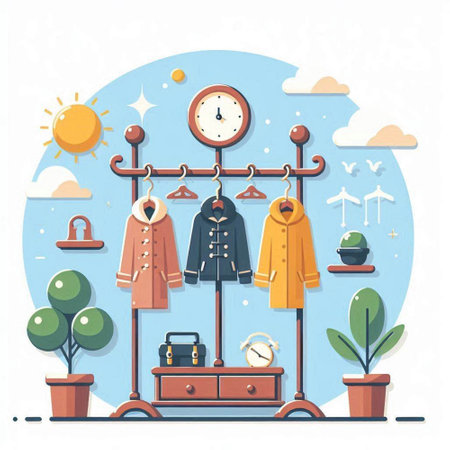The Benefits of a Minimalist Closet
Imagine waking up every morning, opening your closet, and seeing only the clothes you truly love and actually wear. That’s the beauty of minimalist closet organization—a lifestyle shift that goes beyond tidying up. By paring down your wardrobe, you’re not just creating more physical space; you’re giving yourself the gift of time and peace of mind. No more frantic searches for that missing shirt or being overwhelmed by endless choices. Instead, a streamlined closet means faster decision-making and less stress, setting a positive tone for your entire day. In American homes where life can get busy and bedrooms often double as personal retreats, having an uncluttered wardrobe turns your space into a calming sanctuary. Minimalism in your closet isn’t about sacrificing style; it’s about curating your clothing so everything has a purpose and brings you joy. This simplicity naturally spills over into the rest of your home—and your life—helping you focus on what really matters.
2. Decluttering: How to Start Simplifying
Decluttering your closet is the first big step toward a minimalist, stress-free bedroom. The process might seem overwhelming at first, but breaking it down into manageable steps makes it totally doable—even for busy families or anyone new to minimalism.
Step-by-Step Decluttering Guide
- Empty It Out: Take everything out of your closet and drawers so you can see what you own. Spreading items on your bed or floor helps you assess your entire wardrobe at once.
- Sort Into Categories: Group clothing by type—shirts, pants, dresses, shoes, etc.—to make comparisons easier and spot duplicates.
- Try On & Assess: Try on anything you haven’t worn in a while. Ask yourself: Does it fit comfortably? Do I feel confident wearing it? Is this my style today?
- Create Three Piles:
| Keep | Donate | Let Go/Recycle |
|---|---|---|
| Items you wear often and love | Gently used pieces others could enjoy | Torn, stained, or worn-out items |
| Essentials for work, home, special events | Seasonal clothes not your style anymore | Single socks, stretched-out tees |
| Quality over quantity—favorites only! | Duplicates or clothes that don’t fit | Clothes beyond repair—consider textile recycling centers locally |
Smart Decluttering Tips for American Families
- Set a Timer: Give yourself 20-30 minutes per session to avoid burnout—perfect for parents juggling busy schedules.
- The “One Year Rule”: If you haven’t worn something in the past year (excluding formalwear), it’s probably time to let it go.
- Get the Family Involved: Turn decluttering into a family activity with music and snacks. Kids can help decide which clothes they’ve outgrown or no longer like.
- Host a Clothing Swap: Invite friends or neighbors over for a swap party. Everyone brings gently used clothes and leaves with “new-to-them” pieces—fun, free, and eco-friendly!
- Donate Locally: Support your community by donating to local shelters, churches, or organizations like Goodwill and Salvation Army. Many offer convenient drop-off locations or even pick-up services.
A Fresh Start Awaits!
Simplifying your wardrobe isn’t just about having less—it’s about keeping what truly works for your lifestyle. Once you’ve decluttered, you’ll find getting dressed each morning feels lighter and more intentional—leaving more room for what matters most in your home and life.

3. Smart Storage Solutions for Small Spaces
If you’re working with a small bedroom or a limited closet, don’t worry—minimalist organization is totally achievable with the right approach. The key is to think creatively and make every inch count. Start by investing in versatile organizers like stackable bins, clear drawers, or hanging shelves that let you see everything at a glance. These tools help you group similar items together, making it easier to locate your favorite shirt or accessory in seconds.
Multi-Use Hangers: Double (or Triple!) the Space
One of the simplest upgrades you can make is swapping out bulky hangers for slim, multi-use ones. Look for cascading hangers or those designed to hold multiple pairs of pants, scarves, or even handbags. This not only saves space but also keeps your closet looking neat and uniform—no more tangled belts or lost accessories!
Don’t Overlook Under-Bed Storage
Your bed isn’t just for sleeping; it’s also prime real estate for storage! Slide in shallow bins or rolling drawers to store off-season clothes, extra bedding, or shoes. Make sure to label each container so you can easily rotate items as seasons change. By lifting clutter from your closet and putting it under the bed, you’ll instantly create a more calming and organized bedroom environment.
Pro Tip: Keep It Flexible
When choosing storage solutions, opt for pieces that can adapt as your needs evolve. Modular organizers and adjustable shelves grow with you—whether you’re switching up your wardrobe for summer or just picked up a new hobby. With a little creativity and the right tools, even the tiniest closet can become a minimalist’s dream come true.
4. Building a Versatile Capsule Wardrobe
A capsule wardrobe is the heart of minimalist closet organization, offering both simplicity and flexibility for a stress-free bedroom. By carefully selecting timeless pieces that work for every season and lifestyle, you can streamline your choices while always having something stylish to wear. Here’s how to create a capsule wardrobe that fits the American way of life, from chilly winters in Chicago to sunny summers in California.
Choosing Timeless Pieces
Focus on quality over quantity. Select items in neutral colors—think black, white, gray, navy, and beige—which never go out of style and can be easily mixed and matched. Prioritize classic silhouettes like straight-leg jeans, crisp button-down shirts, simple tees, and a well-fitted blazer. For American families, this means investing in clothes that transition seamlessly from work meetings to weekend outings or school events.
Mixing and Matching: The Key to Versatility
The beauty of a capsule wardrobe lies in its versatility. With just a few foundational pieces, you can create outfits suitable for all occasions and seasons. Here’s an example of a basic 12-piece capsule wardrobe for American lifestyles:
| Item | Season(s) | Occasion Examples |
|---|---|---|
| White Button-Down Shirt | All year | Work, brunch, PTA meeting |
| Dark Wash Jeans | All year | Coffee run, movie night |
| Navy Blazer | Spring/Fall/Winter | Interviews, dinner date |
| Striped T-Shirt | Spring/Summer | Museum visit, park picnic |
| Sweater (Neutral Color) | Fall/Winter | Pumpkin patch, Thanksgiving dinner |
| T-shirt Dress | Spring/Summer | Farmers market, family BBQ |
| Knit Cardigan | Fall/Winter/Spring | Library trip, school drop-off |
| Chinos or Khakis | All year | Casual Fridays at work, church service |
| Puffer Vest or Jacket | Fall/Winter | Weekend getaway, morning walks |
| Sneakers (White or Neutral) | All year | Biking with kids, errands |
| Ankle Boots or Loafers | Fall/Winter/Spring | Date night, parent-teacher conference |
| Tank Top (Layering Piece) | Summer/Layering All year | Lounging at home, layered under sweaters |
A Family-Friendly Approach to Minimalism
If you’re organizing your closet for the whole household, involve your partner and kids by choosing versatile basics they’ll actually wear. This makes mornings smoother—no more hunting for matching socks or last-minute outfit changes before school! Embracing a minimalist capsule wardrobe brings peace to your bedroom and gives your family more time for what really matters.
5. Maintaining a Minimalist Wardrobe Routine
Building Easy, Everyday Habits
Keeping your closet minimalist isn’t a one-and-done deal—it’s about developing simple routines that fit seamlessly into your daily life. Try the “one in, one out” rule: when you buy something new, let go of an old item. Make it a habit to hang up or fold clothes right after wearing them, rather than letting them pile up. Once a week, do a quick scan of your closet and put away anything out of place. These easy habits only take minutes but make a big difference in keeping your bedroom calm and clutter-free.
Seasonal Check-Ins: Refresh and Reset
As the seasons change, so do our wardrobes. Schedule four seasonal check-ins each year—think spring cleaning, summer swap, fall refresh, and winter prep. Use these times to review what you actually wear, pack away off-season items, and donate pieces that no longer fit your style or needs. This ritual not only keeps your closet organized but also helps you stay connected to your personal style as it evolves throughout the year.
Dealing with Shopping Temptations
Living in a consumer-driven culture like the U.S., resisting shopping temptations can be tough. Before making a purchase, pause for 24 hours—chances are, the urge will pass if it’s not truly needed. Ask yourself if the new piece adds value or fills a real gap in your wardrobe. Consider making wishlists instead of impulse buys; revisit them after a month to see if you still want those items. And remember, investing in quality over quantity is key—choose versatile pieces that work for multiple occasions and seasons.
Your Closet, Your Sanctuary
By building mindful habits and checking in with your wardrobe regularly, you’ll keep your closet streamlined without stress. Over time, these routines become second nature, helping you create a bedroom environment that feels lighter and more peaceful every day.
6. Creating a Peaceful, Personalized Closet Space
Once youve pared down your wardrobe and streamlined your closet, its time to infuse this space with a sense of calm and personality. Minimalism doesn’t have to mean sterile or impersonal—in fact, a few thoughtful touches can make your closet feel like a true retreat. Here are some ideas for adding simple, comforting elements that reflect who you are and bring you joy every time you open those doors.
Photos That Spark Joy
Add a small framed photo of your loved ones, pets, or a favorite vacation spot on a shelf or inside the closet door. Every time you reach for an outfit, youll get a little boost of happiness and connection—an easy reminder that your closet is part of your home, not just storage.
Scent Sachets for Serenity
Slip in a lavender sachet, cedar block, or another natural scent pouch among your clothing. These not only keep things smelling fresh but also create an instant sense of relaxation when you walk into your closet. Choose scents that help you unwind or energize you for the day ahead.
Your Favorite Quote as Daily Inspiration
Print or handwrite a quote that inspires you on a pretty card and tape it inside the closet door or on a shelf. Whether it’s “Less is more” or something deeply personal, seeing these words each morning will set a positive tone for the day and reinforce your minimalist mindset.
Keep It Functional, Keep It You
The key is to choose just one or two personal touches—enough to make the space feel welcoming without cluttering it up again. Think about what makes you smile or helps you feel at ease: maybe it’s a favorite patterned basket for accessories, a tiny plant (real or faux), or even color-coordinated hangers. By keeping it simple and meaningful, your minimalist closet becomes not only organized but also uniquely yours—a peaceful corner that supports both style and serenity.


